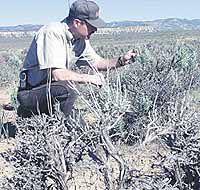| Utah DWR habitat program manager Chris Colt draws attention to dead sagebrush appearing at locations across the county due to the drought. Deer depend on the sagebrush for feed during the winter season and the dying bushes create concerns regarding the future welfare of the wildlife. |
Chris Colt may be one of the few people residing in the Carbon County area hoping for a light winter.
While dead sagebrush may seem innocuous to most Carbon residents, it is not to the Utah Division of Wildlife Resources’ habitat program manager.
Sagebrush virtually provides the life’s blood for mule deer during the winter, especially when the mountains are filled with snow, according to the DWR habitat program manager.
“Basically, so much of this sage is dead, if they can’t eat anything up there because of snow, they will come down here and starve to death,” pointed out Colt as he stood looking at the lifeless plants on Porphyry Bench.
“Some will go down into the valley, but we could have hundreds dead up here,” added the DWR habitat program manager.
The drought and dying sagebrush have literally created the ultimate dilemma.
With no moisture falling in the upcoming winter months, even the most hardy of the sage will die.
Yet with loads of snowfall, the deer that usually rely on the plants for winter feed will die.
Sagebrush is a common sight above a certain altitude in the Rocky Mountain region, explained Colt. But a lot of the plants growing in Utah are in trouble.
In fact, the Utah Division of Wildlife Resources has estimated that 400,000 acres of the sagebrush is in dire stress and will not be able to survive another year without receiving adequate moisture.
Most of the sagebrush people see is old, according to wildlife resources. A bush two feet tall is usually 40 years old or older.
Sagebrush spreads slowly with small seeds that are wind blown only three to 15 feet away from the parent plant.
Right now many of the adult bushes have no green foliage. A few of the sagebrush have some green showing, while there are no immature plants.
“We could just lose all this sage,” indicated Colt. “These plants have a tap root that can go down 30 feet to draw the deep moisture up. With them dying like this, it tells us the moisture is gone from the soil.”
The rain that the area received in early June helped alleviate some drought conditions, but only involving the wild grasses.
“That’s good feed for the elk – they like it,” stated Colt. “The mule deer won’t eat it.”
One grass in the area, however, is a threat to the plants that grow with the grow cover. Cheat grass can drain the life from other plants free roaming animals eat.
“All it is an exotic weed,” explained Colt. “That grass matures faster than the other plants around. Often if the weather is nice, it starts to green up in February and then stays that way until June when it dries up.”
“By that time, it has tapped the moisture from the soil that other plants need to have to survive, especially in drought seasons like this year,” noted the DWR habitat program manager.
Colt explained that cheat grass has a fire cycle of about five years. The wildgrass burns readily when exposed to flames.
“Sage has a fire cycle but it is more like 11 years and those fires that occur in cheat grass damage the sage,” he explained.
One of the problems that Colt foresees this winter is that if the deer start to starve people will want DWR to feed them or local residents will try to do it themselves.
“There are a couple of problems associated with that,” noted the DWR representative. “First there will be way to many deer to feed. It would be very expensive to feed them all for the winter. The other problem is that if we did that it would concentrate all the animals in one place and it could also create a problem with the spread of various diseases they harbor.”
As far as the sage brush dying, there is little that can be done.
“We just want people to know what is happening and how the drought is affecting wildlife. They just need to know what we are up against on this,” concluded Colt.

